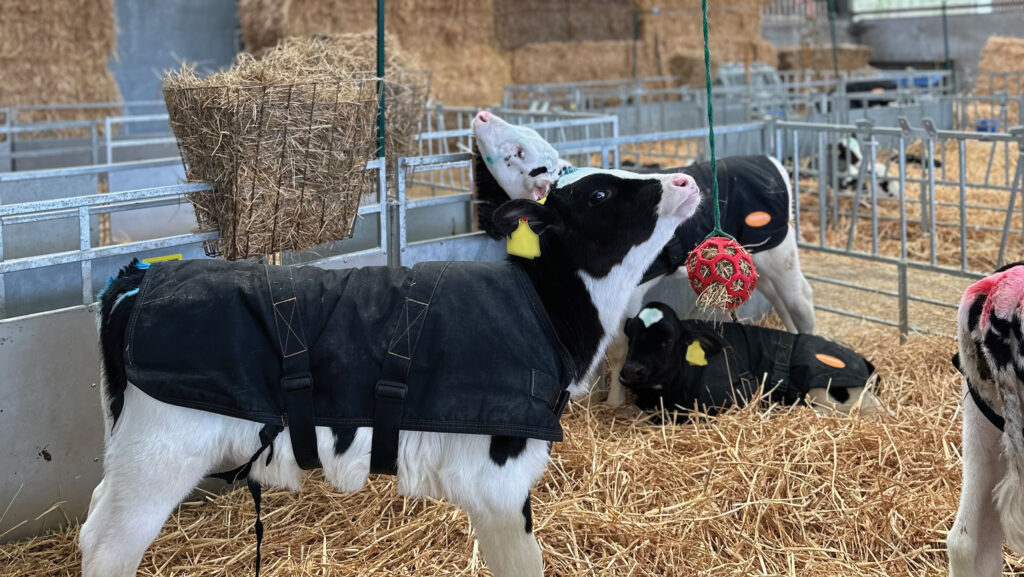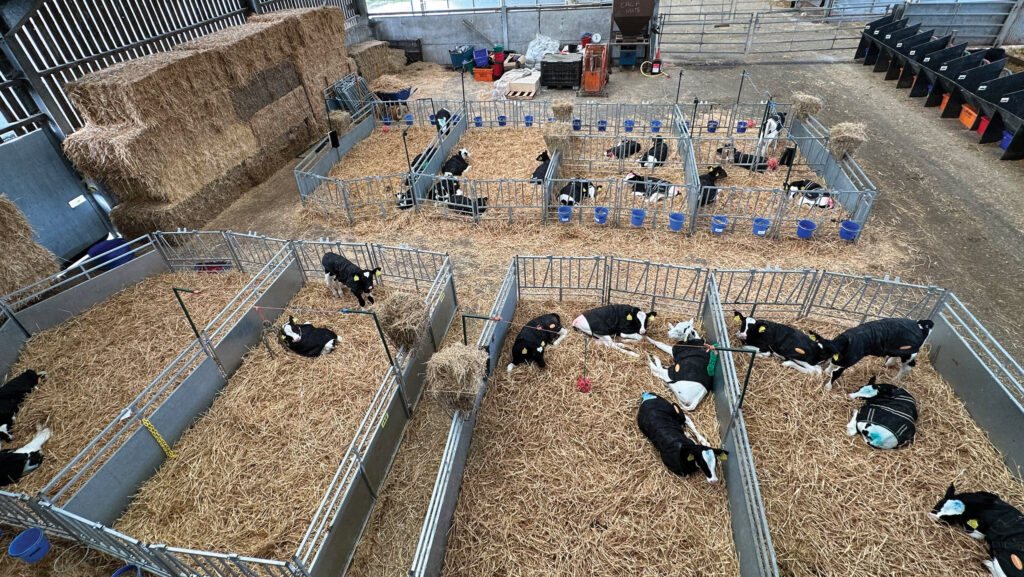Benefits of giving dairy calves toys on farm
 © Ganimet Unsal Polat
© Ganimet Unsal Polat Giving dairy calves plastic “toys” to play with helps them express their natural behaviour which, in turn, benefits their mental wellbeing.
As a result, they are less likely to display unwanted behaviours such as cross-sucking and a new study shows they are better equipped to deal with a stressful event, such as disbudding.
See also: How to group calves for successful social rearing
Researchers at the University of Reading think that evidence will show how creating a better environment for calves – through group rearing, ad-lib milk feeding and enriched environments – will have long-term benefits with dairy herds rearing more robust and adaptable cows.
Calves need to spend their days eating, drinking, sleeping – and playing, says research supervisor Dr Kate Johnson, who is a vet and lecturer in animal science at the University of Reading.
She says it is important to understand how calves spend their day to establish the best management and housing systems.
Learning to eat feed, playing, grooming, socialising and sleeping (around 18 hours a day), calves also need to snuggle with others and have calm, lying-together time.
“To be warm, comfy, full of food – this is what all baby mammals need. And we all want happy, healthy animals.
“It matters from [the context of] doing a decent job, as well as public perception of what we do. But there is also evidence that good health and welfare results in calves doing better,” she says.
Barren environments
On many farms, however, calf rearing is secondary to the main enterprise of milk production.
Little or no investment in facilities means calves are reared in barren environments with restricted milk feeding to save cost.
The upshot is a low level of activity for calves and, because they have too much “free” time and basic needs are not met, they become dull, depressed or bored.
This is when unwanted behaviours appear: calves begin to cross-suck (leading to navel infection) and stand more.
They may also become fearful, or show low-grade aggression such as head-butting, says Kate.

© Ganimet Unsal Polat
“They bite and chew everything they shouldn’t – and fill the day with mischief. We need good ways for calves to display their playful behaviour.
“Calves will be curious and lick their environment, but it is hard to disinfect stone or wood in old buildings, so it’s preferable to give them some cleanable plastic.”
So far, calf welfare research at Reading has shown that reared in groups, calves learn socially by copying each other, says Kate.
“There are more prompts to learn things, such as how to eat hard food.
“It is easier to spot problems sooner [and do something about them] rather than waiting for the traditional sign – a calf going off its feed,” she explains.
Toys stimulate play
As a result of this work, further studies investigated the effects of environment enrichment by evaluating a range of toys as stimulation.
These included home-made items, as well as those sold to the equine market: hanging plastic balls filled with hay; broom heads fixed to pen sides; a teat fixed to stock board; thick rope or a plastic chain hanging down; and a yoyo.
Kate says giving calves the ability to play, naturally feeds into their mental state.
“Most of the time, we want calves to be in a low-arousal, calm environment where they can sleep a lot. But, pre-puberty play is part of natural behaviour and really important for long-term learning.
“Investigating and curiosity – this is how a calf will find water, eat new feed, cope with the parlour, and adapt to change as an adult cow.”
Using the plastic toys in rotation (to allow for disinfection), Kate says the study showed they effectively “stopped calves from being bored”.
Because there is evidence of the comforting effects of toys and having “something nice to do” in domestic pets, Kate says these same calves were then monitored during disbudding.
Impact of enrichment during disbudding
- Disbudding causes pain and stress to calves
- Shown by vocalisation and increased heart rate
- Distraction diverts their attention from stressors
- Social buffering (being with other calves) can reduce stress responses
- 36 Holstein calves allocated to one of four treatment groups (as above)
- Weekly weight and health checks
- Calves observed one day before, during, and one day after, disbudding
- Heart rates monitored using chest straps
- Behaviour collected on CCTV
- Results showed calf standing time in non-enriched groups rose by 17 minutes/three-hour period and calves showed more discomfort
- In paired housing, calves tended to lie alone for longer because of restricted social buffering
Source: Ganimet Unsal Polat, funded by Republic of Turkiye Ministry of National Education
Benefits
The aim was to see whether environment enrichment affected their ability to cope with a stressful event.
Results showed that when they were being reared in groups, with access to toys, calves returned to eating and ruminating more quickly, than calves in pairs, or groups without toys.
“The key message is that calves use enrichment and like a range [of toys] in their environment. It helps them cope with problems in their lives,” she adds.
Kate hopes future research can provide evidence to determine long-term accrued benefits from creating better rearing environments.
Further trials this winter will observe older heifers, establish whether novelty is important – do toys need to be regularly changed – and monitor hygiene levels on the toys.
However, she points out that toys are not a replacement for good management.
Calves need a clean, warm draught-free environment with good ventilation, good nutrition with milk fed through teats, and to be reared in groups, she says.
Calf environment enrichment
Study details
- 12 dairy calves of five to 10 days old
- Calves fed 3 litres of milk replacer in teat feeders twice a day
- Ad-lib hay and straw bedding
- Calf jackets used in cold weather
- Disbudded at seven weeks of age
- Weaned at eight to nine weeks
Method
- Assigned to one of four treatments: pair housed and enriched (with toys) environment; pair housed and non-enriched; or group (four calves) housed and enriched environment; group housed and non-enriched
- Enriched calf pens had three toys (plastic balls filled with hay; broom heads; a teat fixed to stock board; rope or plastic chain; yoyo) changed and disinfected weekly
- Calf behaviour videoed weekly for six weeks
- Weekly health and weight checks
Findings
- Results show providing enrichment increased play, social interaction and investigative behaviour, also lying time
- Enrichment reduced standing time and undesirable behaviour
Source: Clara Fernandez Dawson, Reading University
